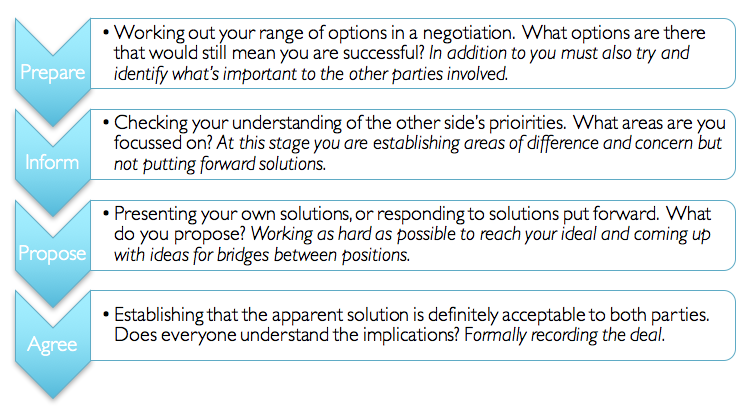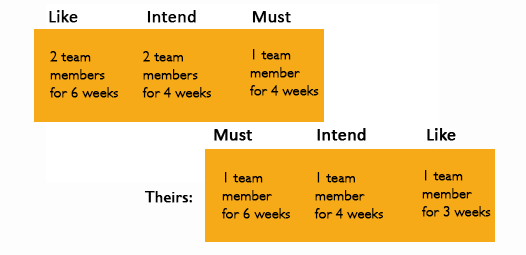Negotiating with others, whether it’s at home with a partner over household chores, or at work with a colleague about help with in a project, is part of everyday life. And reaching an amicable agreement isn’t always easy. People often tell us they walk away from these situations feeling they either haven’t achieved what they wanted to, or that they have given away too much. So what’s the secret of being an effective negotiator?
Confidence, of course, is important. But to acquire that confidence, and negotiate with clarity, taking a, structured approach is critical. Systematically working through a structure keeps you on track and allows you to stay in control from start to finish.
Recognising the importance of negotiating skills, =mc has developed a 4-stage model – PIPA: Prepare, Inform, Propose and Agree – to guide you every step of the way. And when you’re confident in the process, you can be confident in achieving an outcome that works for you and the other person.

Let’s use the example of negotiating with a colleague – we’ll call her Nisha – to apply this structure. You are managing a priority project, and need Nisha to commit her team to completing key project activities within the next few weeks. Tomorrow you have a meeting with Nisha to discuss upcoming work for both teams.
Your negotiation will only be as good as your preparation. This means thinking about Nisha’s position as well as your own. It’s fine to be quick on your feet in response to a proposal from Nisha, but this still needs to be within the context of a clearly thought-out plan. Otherwise you might over-compromise, or fail to bring in what’s important to you in the negotiation. And that then leaves you significantly more likely to come out with a poor deal.
In order to prepare, we recommend you use Gavin Kennedy’s LIM-it model.[1] LIMs are your written list of priorities, divided into Like to get, Intend to get, and Must get.
Back to Nisha. You come up with two key priorities that you need to consider:
You then work out your LIM’s for each factor. Here’s what you come up with for the first one:
| Priorities | Like | Intend | Must |
| How much dedicated time can I get from Nisha’s team members to help deliver the project? | 2 team members involved 2 days a week for next 6 weeks | 2 team members for involved 2 days a week for the next 4 weeks | 1 team member involved 2 days a week for the next 4 weeks |
You need to be particularly clear on your Must. If you can’t get one person from Nisha’s team working for you 2 days a week for the next four weeks, would it be better for you to look elsewhere?
Use this checklist to help you Prepare:
| PREPARE | Do 🙂 | Don’t 😐 |
|
|
Amicable agreements are more likely to come from negotiations where you have a positive relationship, at some level, with the other person – or people. In an internal negotiation you may already have good a relationship with them. But if it’s someone you don’t know – whether internal or external – you will need to factor in time to build rapport at this Inform stage, to enable an easier negotiation later on.
Work to understand as much as possible about the other person’s LIMs and priorities. Share your Likes and Intends to give them a clear indication of your priorities, and encourage them to do the same.
Don’t rush Inform – it will make the Propose stage much easier. If you go too fast, you might be caught out later.
Talking to Nisha, you ask her:
And it would be useful for you to share:
Use this checklist to help you Inform:
| INFORM | Do 🙂 | Don’t 😐 |
|
|
Once you have enough information about what’s important to the other person – or people – you can start to work out where the negotiation can succeed.
The Propose stage is not simply about putting forward a list of what you want. By the time you get here, you should have a good idea of areas of common interest and concern for both sides. Ideally what you propose will reflect where your and their LIMs overlap:

Proposing always seems the most exciting stage of a negotiation and it’s often the one people try to skip to as quickly as possible. If you find the other person trying to move into proposing too quickly, don’t be afraid to bring them back to Inform. (“I’m really excited to talk to you about your proposed solution, but before we do that can I find out a bit more about…”)
Having listened carefully to Nisha in the Inform stage, you work out both your LIMs:

The clear overlap is around 1 team member full time for 4-6 weeks – so this is where a proposal from you is likely to have the most success.
Use this checklist to help you Propose:
| PROPOSE | Do 🙂 | Don’t 😐 |
|
|
Once you have progressed your proposals as far as you can, you need to finish the negotiation.
At this point you need to ask yourself, “Have I achieved what I need to?”
In general the longer you negotiate the more concessions will be traded – on both sides. Overall you need to ensure you’ve achieved your Must at the very least. If you haven’t then you need to weigh up your options:
In their work on principled negotiations, Fisher and Ury developed what they call a ‘Best Alternative to A Negotiated Agreement’ (BATNA). This is about looking at other options if a negotiation isn’t going to work. If you get to this point with Nisha, you might need to bring in a more senior manager to arbitrate and help resolve the situation.
Once you have reached an agreement it’s important to make sure it’s recorded. The agreement must include specifics on any conditions so there can be no confusion further down the line.
You summarise what you’ve agreed with Nisha and record it in an email. (Or you could do this in minutes of the meeting.)
Use this checklist to help you Agree:
| PROPOSE | Do 🙂 | Don’t 😐 |
|
|
Using the PIPA model as a guide allows you to stay in control – and be more confident when negotiating. By moving through the four stages of Propose, Inform, Propose and Agree you are more likely to find an outcome that works for you and the other person or people involved, and the agreement will be mutually beneficial for everyone.
If you’d like to find out more about PIPA, we explore the model and further techniques as part of our Influencing & Negotiating for Results training.
If you’ve found this article helpful and you would like speak to one of our experienced consultants about our Influencing & Negotiating Skills programme, please call +44 (0)20 7978 1516 or contact us online.
[1] Gavin Kennedy, Everything is Negotiable, Cornerstone 2008